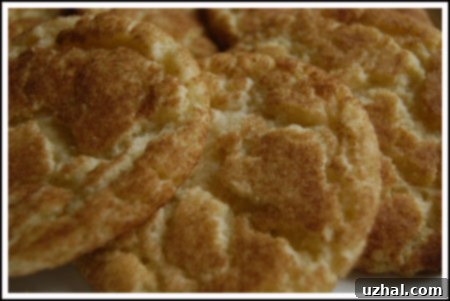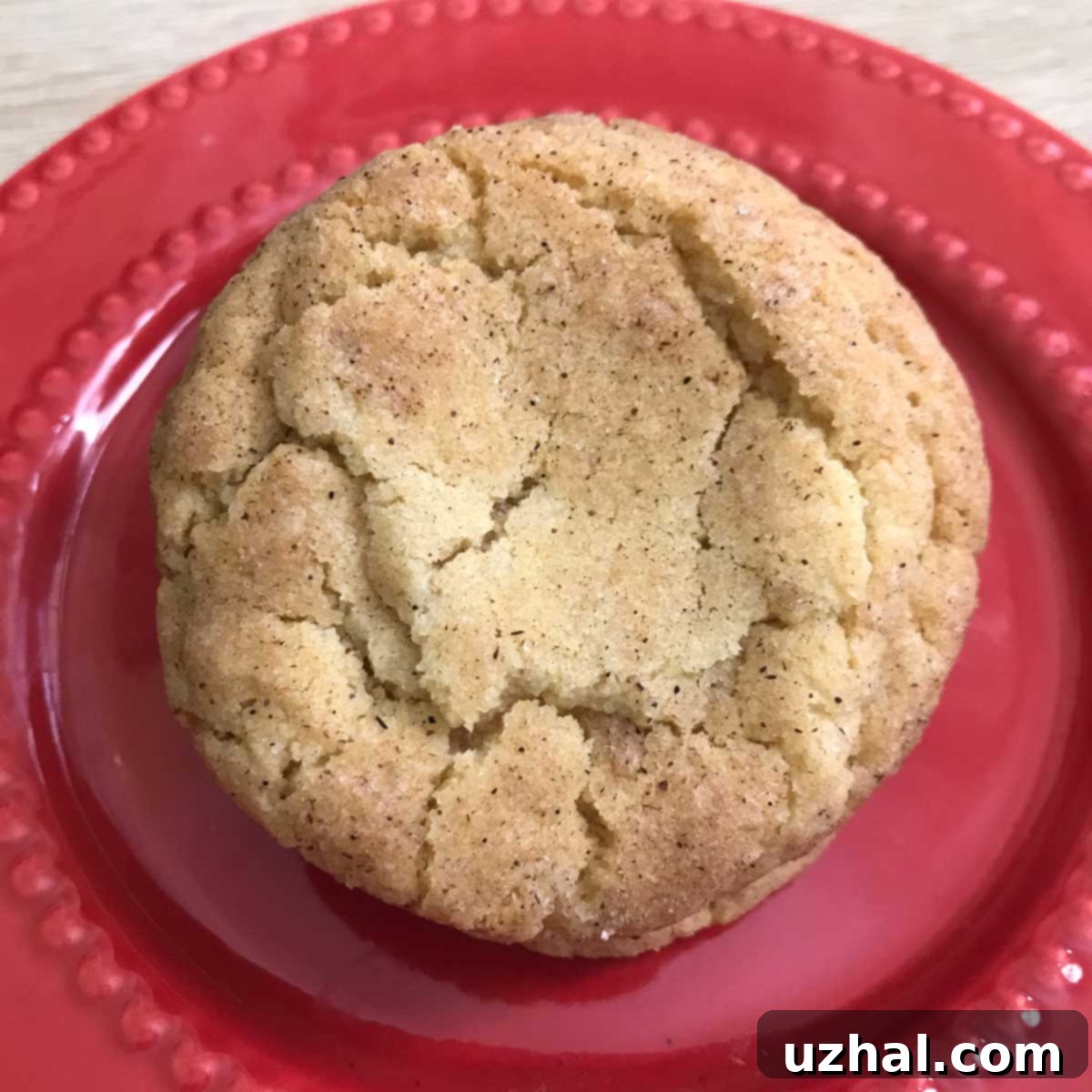Sue’s Snickerdoodles: The Ultimate Guide to Chewy, Crackly Perfection
There are Snickerdoodles, and then there are Sue’s Snickerdoodles. This timeless recipe, which Sue generously shared years ago, has become a cherished staple in my kitchen, just as it is in hers. What makes this recipe truly special is its ability to consistently deliver that perfect balance of chewiness, sweetness, and the signature tangy kick that sets a great Snickerdoodle apart. While Sue is a true purist, sticking exclusively to granulated sugar for her classic rendition, I sometimes enjoy a subtle twist. Swapping out a portion of the granulated sugar for rich brown sugar introduces an extra layer of moisture and a deeper, more complex caramel note, elevating the cookie’s chewiness to new heights. However, whether you choose the traditional path or experiment with a touch of brown sugar, the foundation of this recipe ensures an unforgettable Snickerdoodle experience every single time.
One fundamental aspect that both Sue and I staunchly agree upon is the absolute necessity of cream of tartar in a Snickerdoodle recipe. This often-overlooked ingredient is not just an optional addition; it is the cornerstone of the cookie’s unique character. Cream of tartar reacts with baking soda to create the perfect leavening, but more importantly, it imparts a distinct tangy flavor that is synonymous with authentic Snickerdoodles. Without it, you’re essentially making a cinnamon sugar cookie, not a true Snickerdoodle. Beyond flavor, the ideal Snickerdoodle should always be wonderfully chewy, never dry or cakey. This recipe excels at achieving that desired texture. Furthermore, a beautiful, crackly top is a non-negotiable hallmark of a well-made Snickerdoodle, and this particular recipe consistently delivers those aesthetically pleasing cracks. For those who desire an even more pronounced crackle and a depth of flavor that develops over time, chilling the dough is a simple yet highly effective technique that truly elevates the final result.

The Secret to Superior Snickerdoodles: Cream of Tartar and Ideal Texture
Many home bakers might wonder about the specific role of cream of tartar. It’s a powdered acid that, when combined with baking soda, produces carbon dioxide gas, which helps the cookies rise. However, its contribution goes far beyond simple leavening. Cream of tartar is crucial for two main reasons: it lends that signature subtle tang that defines a Snickerdoodle, distinguishing it from a regular sugar cookie, and it plays a vital role in creating the tender, chewy interior and those coveted crackly tops. Without cream of tartar, cookies tend to spread more, become flatter, and lack the characteristic chew and flavor profile. This recipe masterfully harnesses its power to ensure every bite is authentic and satisfying.
Beyond the ingredients, achieving the perfect Snickerdoodle texture involves a delicate balance of fat, sugar, and flour, along with precise baking techniques. We aim for a cookie that is soft and yielding in the center, with slightly crisp edges, and a surface adorned with beautiful, natural cracks from the cinnamon sugar coating. This recipe achieves exactly that – a cookie that offers resistance with each bite, then melts in your mouth, leaving a delightful blend of sweet and tangy flavors. The crackled top isn’t just for looks; it adds another layer of texture, a subtle crunch before you hit the chewy interior.
Regular vs. Insulated Baking Sheet: The Great Snickerdoodle Experiment
A few years ago, when we first began sharing this phenomenal recipe, a fascinating debate emerged among bakers: would Sue’s Snickerdoodles achieve their optimal crispness on a traditional, regular baking sheet, or would an AirBake insulated baking sheet yield superior results? Always one for culinary experimentation, Sue embarked on a mission to uncover the truth. Her findings were conclusive and shed valuable light on the nuances of cookie baking. Through meticulous testing, she unequivocally determined that the cookies were indeed crispier and boasted a more desirable texture when baked on a regular baking sheet. Insulated sheets, designed to prevent over-browning, often create a softer, less crispy cookie, which isn’t the goal for a perfect Snickerdoodle.
But the revelations didn’t stop there. Sue also discovered another crucial factor in optimizing Snickerdoodle quality: chilling the dough. Her experiments revealed that dough chilled for two days produced cookies with a noticeably better texture, a richer flavor profile, and, perhaps most importantly for aesthetic appeal, more pronounced cracks on their surface. This extended chilling period allows the flavors to meld and develop, and the butter to firm up, resulting in less spread during baking and a more uniform, chewy texture. So, while you can certainly bake these cookies right away, if you have the foresight and patience to chill the dough, even for a few hours, you will be rewarded with a profoundly enhanced Snickerdoodle experience. The difference in chewiness and the depth of the cinnamon-sugar flavor is truly remarkable and well worth the extra step.
Sue’s Snickerdoodles Recipe: A Timeless Classic
Here it is: the renowned recipe from Sue that consistently produces delightfully chewy and crispy Snickerdoodles. This particular version has been shared and celebrated, earning its reputation as a go-to for many. You can find the original recipe from Sue here, and for your convenience, I’ve also made it fully printable below within the structured recipe card. Over the years, I’ve introduced a couple of minor tweaks that I find enhance the flavor even further without straying too far from the original’s perfection. I prefer to use ¾ teaspoon of salt instead of the customary ½ teaspoon; this slight increase subtly intensifies the overall flavor and balances the sweetness. Additionally, as mentioned earlier, I sometimes swap out half of the granulated sugar for brown sugar, which contributes a wonderful chewiness and a deeper, more caramelized note. Feel free to experiment with these variations or stick to Sue’s original – both approaches yield exceptional results.
For those who adore Sue’s Snickerdoodles and are keen to explore more of her recommendations, I highly encourage you to check out another fantastic recipe she stands by: Mrs. Fields Cinnamon Sugar Butter Cookies. It’s another excellent choice for anyone who appreciates the comforting flavors of cinnamon and butter in a perfect cookie package.
Exploring Variations: The Schneckerdudel and Beyond
My journey through cookie recipes recently led me to an intriguing discovery in a charming little Texas-German cookbook: a recipe for something called “Schneckerdudel.” Naturally, my curiosity was piqued, and I set out to compare it to the gold standard of Snickerdoodles set by Sue. While the Schneckerdudel, in my humble opinion, didn’t quite reach the sublime heights of Sue’s recipe, it was remarkably close in its foundational ratios, suggesting a shared culinary lineage. What truly made the Schneckerdudel stand out, however, was its unique flavoring. Instead of the ubiquitous vanilla extract typically found in Snickerdoodles, this recipe called for almond extract. This simple substitution opened up a world of possibilities for customizing your Snickerdoodles. If you’re looking to introduce a sophisticated twist to these classic cookies, incorporating a touch of almond extract alongside or in place of some of the vanilla can yield a delightful new flavor profile. It adds a subtle nuttiness and a more aromatic quality that can be quite appealing. This goes to show that while classics are beloved for a reason, a little experimentation can lead to exciting new culinary adventures.
Tips for Perfect Snickerdoodles Every Time
- Room Temperature Ingredients: Ensure your butter, shortening, and eggs are at room temperature. This allows them to cream together properly, creating a smooth, emulsified dough that will bake evenly.
- Don’t Overmix: Once you add the dry ingredients, mix just until combined. Overmixing develops the gluten in the flour, leading to tougher cookies.
- Measure Accurately: Especially with flour, precise measurements are key. Too much flour can result in dry, crumbly cookies. Consider using a kitchen scale for the most accurate results.
- Use Parchment Paper: Lining your baking sheets with parchment paper prevents sticking and ensures even baking, making cleanup a breeze.
- Chill if Possible: As Sue’s experiment showed, chilling the dough for at least an hour, or even up to two days, significantly improves texture, flavor, and crackle.
- Even Scooping: Use a cookie scoop to ensure all your cookies are the same size. This promotes uniform baking, so all your cookies are done at the same time.
Serving and Storage
Sue’s Snickerdoodles are best enjoyed fresh from the oven, still warm and slightly soft. Pair them with a cold glass of milk, a hot cup of coffee, or a comforting mug of tea for an exquisite treat. These cookies are perfect for holiday gatherings, potlucks, or simply as an everyday indulgence. To store, place cooled cookies in an airtight container at room temperature for up to 3-4 days. For longer storage, you can freeze the baked cookies for up to 2-3 months. Thaw at room temperature, or warm gently in the microwave or oven for that freshly baked taste.
Recipe

Sue’s Snickerdoodles
Anna
Pin Recipe
Ingredients
- 2 ¼ cups all-purpose flour (315 grams)
- 2 teaspoons cream of tartar
- 1 teaspoon baking soda
- ¾ teaspoon salt
- ¾ cup unsalted butter softened (170 grams)
- ¼ cup butter flavored shortening (48 grams)
- 1 ½ cups granulated sugar (or use half white and half brown) (300 grams)
- 2 large eggs bring to room temperature
- 2 teaspoons vanilla extract
- Cinnamon Sugar: 3 tablespoons granulated sugar 36 grams plus 1 ½ teaspoons cinnamon
Instructions
-
Preheat oven to 375 degrees F (190 degrees C). Line cookie sheets with parchment paper for best results and easy cleanup.
-
In a medium bowl, whisk together the flour, cream of tartar, baking soda, and salt. Set aside.
-
In a large mixing bowl, using the low speed of an electric mixer (or by hand with a sturdy whisk), cream together the softened butter and butter-flavored shortening until just combined. Add the granulated sugar (or your chosen sugar blend) and mix on low speed until just blended – avoid over-creaming, as this can incorporate too much air. Add the eggs one at a time, beating on low speed after each addition until fully incorporated and the mixture is smooth. Finally, beat in the vanilla extract until just combined.
-
Gradually add the dry ingredients to the wet ingredients, mixing on low speed until just combined and no streaks of flour remain. Be careful not to overmix. Using a medium cookie scoop (about 1.5 tablespoons), portion out rounds of dough. This should yield approximately 30 cookies. If using a larger scoop, you’ll get about 16 cookies. At this stage, you have the option to chill the dough balls for at least 1 hour, or up to 2 days, for enhanced texture and flavor, or proceed to bake immediately.
-
In a small, shallow bowl, mix together the cinnamon and the 3 tablespoons of granulated sugar for the coating. Roll each dough ball generously in the cinnamon-sugar mixture, ensuring it’s fully coated.
-
Place the rolled dough balls about 2 inches apart on the prepared cookie sheets. Bake at 375 degrees F (190 degrees C) for 9-11 minutes, or until the edges are lightly golden brown and the centers are still slightly soft. Do not overbake.
-
Remove cookies from the oven and let them cool on the baking sheet for 5 minutes before transferring them to a wire rack to cool completely. This helps them set and retain their shape.
Notes
